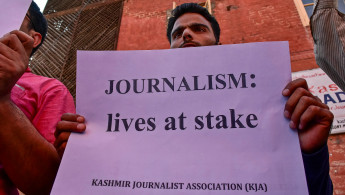Journalists in Kashmir face tough challenges
Prior to this, a number of journalists were barred by government forces from covering the funeral of PhD Scholar turned rebel commander, Dr Manan Wani, making it impossible for journalists to carry out their professional duties. But these two incidents were of course not the first time journalists were beaten or barred.
In 1995 a parcel bomb was planted at the office of senior journalist, Yusuf Jameel, which resulted in the killing of his colleague Mushtaq Ali. On June 14, 2018 during the month of Ramadan, Shujaat Bukhari, the editor of local daily, Rising Kashmir, was mercilessly killed with his two security guards outside his office in the press enclave of Srinagar. He was attacked by three individuals on a motorcycle who police claimed belonged to Kashmiri rebel group Lashkar-i-Toiba.
Many journalists have also faced arrests. In September 2017, Kamran Yousuf, a freelance photographer was arrested by the National Investigation Agency (NIA) and in 2018, Auqib Javeed, a reporter for a local daily in Kashmir was summoned by the same agency in connection with a story on related to the chief of the all-woman Islamic group, Dukhtaran-e-Millat, Asiya Andrabi.
Later in September, Asif Sultan, the assistant editor of local magazine, Kashmir Narrator, was arrested by local police for allegedly 'harbouring known terrorists' and glorifying militants through his writing.
|
While Asif Sultan is still lodged in jail, Kamran Yousuf is out on bail and Auqib Javeed was let off after three days of questioning, but the journalists here remain in constant fear while covering or reporting from ground zero.
Around 21 journalists have been killed since the year 1990 in restive Kashmir and hundreds of violent incidents have taken place where journalists are attacked, both verbally and physically, at the hands of government forces. Yet no one has been held accountable for these acts by the state till date.
Journalist Saqib Mugloo, who was physically assaulted by government forces a day after the Fateh Kadal encounter on October 16, says the mechanism of the state security apparatus is "heavily running on journalists while they are out to report." He adds that is has become difficult to report facts in a state where journalists are met with abuse and assault.
As per the annual report of media watchdog, Reporters without Borders, out of 180 countries India ranks at 138th place in press freedom, citing the main reason as 'physical violence' against journalists.
Referring to Kashmir, RSF said in their report that "coverage of regions that the authorities regard as sensitive, such as Kashmir, continues to be very difficult". It added that foreign reporters are barred from the region and the "internet is often disconnected there". Furthermore, Kashmiri journalists working for local media outlets "are often the targets of violence by soldiers acting with the central government's tacit consent".
Another report titled Kashmir's Media in Peril notes that in Kashmir, along with the Maldives, is a zone in South Asia in "need of urgent intervention to protect press freedom and journalists' rights".
The report has said that the media has "suffered in the form of killings, direct attacks, intimidation, threats and pressures from various quarters. Twenty-one journalists have been killed due to the conflict – either directly targeted or caught in the crossfire."
Read also: Blinded in Kashmir: Scores of women injured by India's counter-insurgency crackdown
Many promising journalists have also had to quit their profession before they could start off due to these threats. Shreen Hamdani, now a teacher, used to work as an online editor for a local magazine. She tells The New Arab that journalists in the region "work tirelessly but are offered peanuts in return, which makes many aspiring journalists switch off and turn to other professions."
Journalist Mohammad Raafi, who works for local daily Kashmir Reader, tells The New Arab: The media sector in Kashmir is financially unorganised. It does not guarantee job security to its workers. Journalists with university degrees and professional skills are paid peanuts. Many journalists give up their career in media and switch to other options primarily because of lack of financial security in the sector."
These contentions have also been pointed out in a report by the International Federation of Journalists, noting that in Kashmir there are "no appointment letters, no medical benefits, no insurance or pensions or provident funds" for journalists. Written contracts are not drawn up and jobs and work assignments go according to oral agreements which are not binding." The report also mentioned a "lack of support from employers," highlighting the case of photojournalist, Kamran Yousuf, who was picked up on September 5, 2017 by the NIA is still languishing in Delhi's Tihar jail with no charges framed against him and no support.
"A journalist in Kashmir is always at risk. The pressures and pulls are many, but there is no protection or support system," Raafi added.
|
List of journalists killed in Kashmir |
Nusrat Sidiq is a legal and human rights reporter working for Kashmir Reader. Her articles have also been published in Asian Times and Indian Water Portal.
Follow her on Twitter: @nusratsidiq



